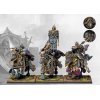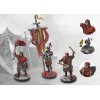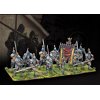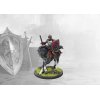Hundred Kingdoms
Sheltered by the selfless sacrifices of the last Legion, the refugees that managed to escape the cataclysm of the Fall would survive the Long Winter that followed and, in time, prosper to found one of the largest and most diverse bastions of human civilization on Eä. Today, the Hundred Kingdoms extend from the sheltered Heartlands by the Bitter Sea, all the way to the lands of the Russ, which stretch against the Claustrine Mountains, before one descends into the corruption and darkness spawned by the Fall beyond them.
Despite the best efforts of the Orders, the spiritual successors to the legendary last Legion, the Hundred Kingdoms have been riven by war almost from the moment the first desperate refugees laid eyes on the Bitter Sea. Peace has only visited their lands twice: once, upon the return of the Orders from the Claustrine Wall at the onset of the Long Winter, and again during the rule of the Armatellum dynasty that managed to briefly unite the Hundred Kingdoms under one banner and found the Tellian Empire.
The tragic end of that dynasty saw the Empire plunged into chaos and brought the resurgence of the Hundred Kingdoms. Today, the Hollow Throne and a few key institutions are all that remain of the Empire while, year after year, would be Emperors and conquerors perpetuate the cycle of violence that make an Empire a quickly fading dream.
With Spires and Dweghom Holds scattered in their lands, pressured by the constant aggression of Nord raids and riven by centuries of internecine warfare, the Hundred Kingdoms are militarized to an unprecedented degree. The feudal system that underpinned the old society is buckling under the assault of an increasingly complex trade-based economy and an ever-increasing demand for manpower. A new class of professional soldier has risen, men and women who fight not for land or obligation but for simple gold. While these ‘men at arms’ are covering the demand for manpower across the Hundred Kingdoms, they also represent a significant destabilizing force. Power is starting to shift away from the traditional landowning aristocracy and into the hands of their rulers, who hold the rights of taxation and can use that coin to purchase the manpower they need to keep their recalcitrant vassals under control.
To this volatile mix, one must add the growing assertiveness of the Faith. Their extensive holdings, and alliances with the Nobility, are allowing them to circumvent the old covenants and field a military force through proxies. As long disused muscles are being flexed, the ancient animosity between faiths is coming to the fore, with the Theist and Deist dogmas marshaling their power and supporters, getting ready to take their arguments from the religious Councils and onto the battlefield.
Standing against this rising tide are the Orders, warriors without peer whose prowess verges on the supernatural, a mantle and burden inherited from the shattered Legion that birthed them. Bound by their common cause to protect mankind from a hostile world, the Orders are split along ideological lines on how best to do this. Ranging from the fanatical devotion of the Order of the Sword, to the calculated interventions of the Order of the Sealed Temple, the Orders are the strongest check to the rising power and aggression of the Church and the all-too numerous local rulers.
Allies in these efforts can be found among the remaining institutions of the Empire. In the desperate days that followed the collapse of the Tellian Empire, the Imperial Conclave deemed the accumulated wealth of the Imperial family too great to risk distributing amongst its members. Thus, the Office of the Imperial Chamberlain was founded, to manage the estate until a new Emperor could be elected. Though his direct power is limited, the Imperial Chamberlain holds tremendous influence among the Imperial institutions he funds and supports: the Mint and its Gilded Legion, the Collegia and the Imperial War Colleges, as well as the Imperial Courts, often the last hope of the common man to receive a just ruling. Despite the best, and often stubborn, efforts of the most influential of sovereigns, these institutions have retained a measure of autonomy and independence, providing a stabilizing factor among the claimants of the Hollow Throne in no small measure due to the terrifying efficacy of the Steel Legion, the only Imperial Legion that refused the call to disband following the death of the last Emperor.
As a result, the forces of the Hundred Kingdoms can display tremendous variety, from a staunchly traditional feudal levy, reinforced by men at arms hired by a sympathetic Church, to an eclectic mix of professional Imperial Legionnaires and feudal allies, stitched together by the Imperial Chamberlain and backed by the brutal pragmatism of the Order of the Crimson Tower.


























